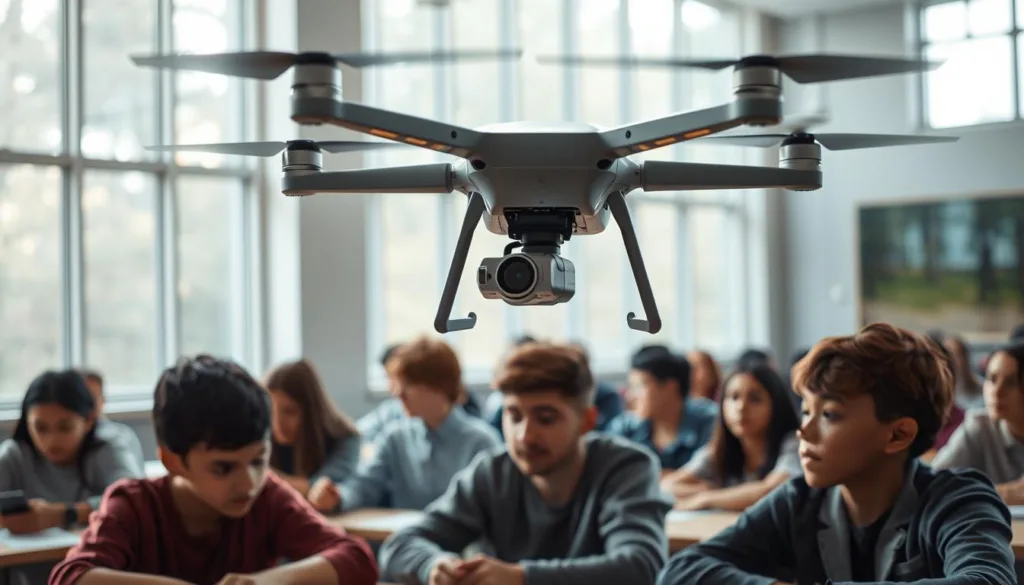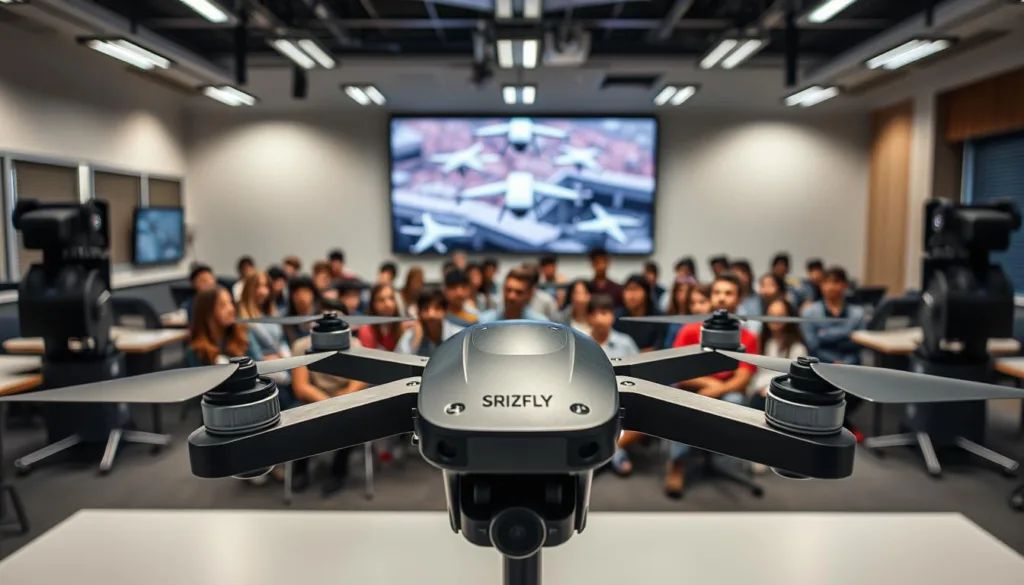Today, drone simulation technology is revolutionizing how we engage students in STEM education. An educational drone simulator allows learners to explore the principles of flight and aerodynamics in a safe and effective manner, eliminating the risks associated with real piloting. As UAV technology increasingly infiltrates various industries, educational institutions utilizing simulators like SRIZFLY not only showcase cutting-edge technological skills, but also equip students for future careers in aviation and related fields. We believe that embracing an interactive drone simulator is essential to fostering an innovative learning environment.
Key Takeaways
- Drone simulators enhance STEM education by providing practical experiences.
- Engagement in learning increases through interactive technology.
- Students gain crucial skills for future aviation-related careers.
- Safety is prioritized with simulations over real piloting.
- SRIZFLY simulators demonstrate cutting-edge technology in classrooms.
Why Choose a Drone Simulator for Education?
Integrating drone simulators into educational settings offers remarkable advantages. The benefits of aviation and drone technology extend far beyond the classroom, impacting various fields like agriculture, logistics, and environmental science. Through immersive learning experiences, educators harness the power of technology to keep students engaged and motivated.
Benefits of Aviation and Drone Technology
Utilizing drone technology in education provides numerous benefits. Schools can prepare students for roles in various industries, such as aerial surveying, crop monitoring, and disaster management. This integration not only enhances practical skills but also allows educators to showcase the relevance of lessons in real-world applications.
Enhancing Student Engagement
Using drone simulators significantly enhances student engagement. Interactive lessons promote interest in STEM subjects, sparking curiosity and motivating learners to participate actively. Students report higher levels of enthusiasm and retention when involved in hands-on activities that incorporate drone technology.
Preparing for Future Careers
Preparing future careers with drones is crucial in today’s job market. By introducing students to UAV operation and programming, educators cultivate skills that align with industry demands. Reports indicate that exposure to drone technology equips students with improved problem-solving and collaborative skills, essential for success in future employment.
Introduction to SRIZFLY Drone Simulators
SRIZFLY specializes in providing innovative drone simulators tailored for educational environments. Our advanced technology allows instructors to equip students with valuable skills without the logistical challenges associated with physical drones.
Overview of SRIZFLY’s Features
The SRIZFLY simulators boast an array of features designed to enhance the learning experience. Key attributes include realistic flight dynamics, a user-friendly interface, and versatile customizability. Students can engage in various flight scenarios that prepare them for real-world applications, reinforcing both technical knowledge and hands-on experience.
Integration with Educational Environments
SRIZFLY simulators integrate seamlessly into a range of educational environments, from traditional classrooms to vocational training programs. This flexibility allows educators to incorporate drone technology into their curricula, fostering a dynamic learning atmosphere that encourages collaboration and innovation among students.
Cost-Effective Solutions for Schools
Recognizing budgetary constraints in many schools, SRIZFLY offers cost-effective drone solutions without compromising quality. Our simulators are designed to provide comprehensive training at an accessible price point, helping institutions invest in cutting-edge technology and ultimately improve student outcomes.
Realistic Flight Training Capabilities
In today’s rapidly evolving education landscape, SRIZFLY’s drone simulators offer unparalleled realistic flight training capabilities. These tools create a compelling environment where students can hone their piloting skills under various simulated flight conditions, enhancing their understanding of drone technology.
Simulated Flight Conditions
Our simulators expertly replicate real-world aviation scenarios, allowing students to experience diverse environmental factors. From varying wind speeds to unpredictable weather conditions, every aspect of flying is covered. This immersive environment helps students prepare for real-life flying without the risks associated with actual flights.
Scenario-Based Learning
Engagement in drone training is heightened through scenario-based learning. Students face predefined challenges, allowing them to think critically and make quick decisions in a controlled setting. This method mirrors actual drone operations, fostering both familiarity and confidence in their piloting abilities.
Safety Measures in Virtual Simulations
Safety remains a top priority in our virtual simulations. Enhanced safety measures ensure that learners can fully engage without worrying about battery failures or crashes, which often hinder traditional flight training. By providing a risk-free learning environment, we promote confidence among new pilots and focus on developing their skills effectively.

FAA-Aligned Curriculum Support
Incorporating a drone simulation program into educational settings provides significant advantages. An essential aspect of this integration involves establishing a comprehensive FAA-aligned curriculum that aligns with current regulations and standards. By focusing on the Part 107 certification, educators ensure that students are prepared for the challenges of the drone workforce.
Understanding Part 107 Certification
The Part 107 certification is a valuable credential for anyone looking to operate drones commercially. This certification outlines the operating rules for small unmanned aircraft systems (UAS) and represents the baseline knowledge needed in the industry. Our simulators are designed to cover the critical components of this certification, enabling instructors to teach students effectively about regulatory compliance and safety measures.
Curriculum Integration Strategies
Implementing SRIZFLY’s flight simulators within existing educational frameworks is straightforward. We provide tools that facilitate the adequate integration of drone training, ensuring that the FAA-aligned curriculum complements STEM and other related subjects seamlessly. Teachers can easily incorporate practical flight experiences while aligning with their current lesson plans.
Meeting Educational Standards
Achieving educational standards in drone training is crucial for student success. Our training programs are aligned with the latest educational benchmarks, thus equipping learners with the necessary skills to excel. By emphasizing safety, operation procedures, and technical knowledge, students gain a robust foundation that enhances their employability in the rapidly evolving drone industry.
Customizable Scenarios for Diverse Learning
In the evolving landscape of drone education, the ability to create customizable drone scenarios enhances the learning experience. SRIZFLY’s simulators allow educators to develop training modules that cater to various skill levels, ensuring that each student engages meaningfully with the material. This flexibility supports diverse learning styles, helping instructors to meet the unique needs of their students.
Tailoring Training Modules for Different Skill Levels
With customizable training modules, educators can design lessons that range from basic introductory concepts to complex applications. This approach aids in scaffolding knowledge, allowing students to build confidence as they progress through their training. By adjusting difficulty levels and content, educators provide a personalized learning experience that promotes engagement and understanding.
Industry-Specific Applications
The integration of industry-specific drone applications into training modules equips students with practical knowledge applicable to fields such as agriculture, construction, and emergency services. These real-world contexts enhance the learning journey, allowing students to connect theoretical concepts with practical skills and industry requirements.
Creating Challenging Flight Scenarios
Challenging flight scenarios stimulate critical thinking and problem-solving skills. Educators can develop realistic situations that simulate actual flight challenges, encouraging students to navigate and adapt to varying conditions. This method not only prepares students for real-life applications but also fosters resilience and adaptability, essential traits for their future careers.
Benefits of a Virtual Learning Environment
A virtual learning environment through drone simulators brings transformative advantages to educational settings. These platforms significantly enhance students’ ability to gain practical skills while ensuring a safe framework for learning. By utilizing these innovative tools, educators can effectively simulate real-world scenarios that foster a hands-on experience without the risks associated with actual drone operations.
Supporting Hands-On Experience
Drone simulators create opportunities for students to engage in hands-on experience that closely mirrors real-life challenges. This interactive approach enables learners to experiment with various flight paths and maneuvers, all while developing essential competencies. Students also acquire problem-solving skills that are critical in the growing field of drone technology.
Risk-Free Learning Opportunities
With the integration of virtual learning, students embrace a risk-free environment that encourages experimentation. Mistakes become a vital part of the learning process, empowering students to explore innovative solutions without facing the dangers of unsupervised drone flights. This supportive climate cultivates a culture of innovation that can redefine how drone education unfolds.
Flexibility for Remote Learning
The flexibility offered by remote learning with drones expands access to quality training resources. Schools can seamlessly incorporate drone education into their curricula, regardless of geographical restrictions. This adaptability allows institutions to meet diverse student needs while maximizing engagement through a modern educational framework.

| Feature | Traditional Learning | Virtual Learning with Drones |
|---|---|---|
| Student Engagement | Limited interaction | High interaction and participation |
| Safety | Potential hazards | No risk during practice |
| Accessibility | Location-based limitations | Available anytime, anywhere |
| Skill Development | Basic understanding | Advanced hands-on experience |
Implementing a Drone Training Program
Successfully launching a drone training program involves a series of carefully structured steps. By starting with a comprehensive needs assessment, educational institutions can identify their objectives and resource availability. This foundational step sets the tone for effective training and successful outcomes in the program.
Steps to Launching the Program
To ensure a smooth implementation, schools should consider the following:
- Conduct a thorough needs assessment to align the program with educational goals.
- Identify necessary resources, including technology and instructional materials.
- Develop a structured plan that outlines the program’s objectives and timelines.
Training Educators and Staff
Training educators in drones is vital for the success of the program. This involves equipping staff with the skills and knowledge to effectively utilize drone technology in the classroom. Professional development sessions can greatly enhance their confidence and ability to engage students.
Evaluating Student Progress
Regular student progress evaluation is essential in determining the effectiveness of the program. By implementing continuous assessment strategies, educators can gather data on student understanding and skills development. This information allows for adjustments to be made to enhance learning outcomes.
Success Stories from Vocational Schools
Several vocational schools have adopted innovative approaches to enhance their STEM education transformation initiatives. We have witnessed remarkable success stories showcasing effective integration of SRIZFLY simulators into educational frameworks. These initiatives not only elevate student engagement but also foster career-oriented skills in the booming drone technology sector.
Case Study: Transforming STEM Education
One notable case study reveals how a leading technical college implemented SRIZFLY simulators in their curriculum. The integration led to a surge in student interest in STEM subjects and hands-on learning experiences related to drone technology. By utilizing simulation technology, students experienced realistic flight scenarios that bridged theoretical knowledge with practical application.
Feedback from Instructors and Students
Instructors have provided overwhelmingly positive feedback, highlighting that the program has significantly improved collaborative learning outcomes. Students report feeling more prepared for real-world applications of their skills, expressing enthusiasm for entering the drone industry. This feedback underscores the value of hands-on experience in solidifying foundational STEM concepts.
Industry Partnerships and Outcomes
Partnerships with industry stakeholders have been crucial in reinforcing the relevance of vocational programs. These alliances offer students pathways to emerging job opportunities, particularly in sectors like logistics, agriculture, and emergency response. The success stories from these vocational schools demonstrate the transformative effect that SRIZFLY simulators and strategic partnerships can have on the educational landscape.
| Vocational School | Integration Year | Student Engagement Increase | Industry Partnerships |
|---|---|---|---|
| Leading Technical College | 2022 | 30% | Logistics, Agriculture |
| Innovative STEM Academy | 2023 | 40% | Emergency Response, Mapping |
Future of Drone Training in Education
The future of drone training in education is set to undergo significant transformations, driven by ongoing advancements in technology. As future trends in UAV continue to unfold, educational institutions can leverage these innovations to enhance learning environments. The integration of emerging technologies fosters a dynamic atmosphere where students can explore their creativity and develop essential skills.
Trends in UAV Technology
The rapid evolution of UAV technology offers exciting opportunities in education. Key trends include:
- Integration of artificial intelligence for personalized learning experiences.
- Use of automated flight paths to streamline lesson planning.
- Enhanced programming capabilities allowing students to engage in real-world applications.
Promoting Innovation in Learning Environments
Incorporating UAV technology into the classroom promotes innovation in education. By embracing these advancements, educators cultivate critical thinking and problem-solving skills. Adopting new methodologies encourages students to experiment and develop projects that reflect their learning. This approach not only enhances engagement, but also prepares students for the evolving job market.
Long-Term Benefits for Students
The long-term student benefits of drone education extend beyond technical skills. Through exposure to UAV technology, students build analytical skills and learn to navigate ethical considerations related to drone usage. This foundation prepares them for challenges they may encounter in both their professional careers and everyday lives. As they progress, the knowledge and skills gained from drone training will empower them, creating a workforce equipped to thrive in an advanced technological landscape.
Maximizing Engagement with Interactive Features
The incorporation of interactive features in drone training brings an opportunity for educators to elevate student engagement significantly. Utilizing techniques such as gamification in education results in a dynamic learning environment where students can thrive. The integration of cutting-edge technologies like virtual reality in drone training further immerses students, making complex concepts more accessible and enjoyable.
Gamification in Flight Training
Gamification transforms traditional flight training into an exciting experience. By integrating game elements into drone training lessons, students remain motivated as they complete challenges, earn rewards, and track their progress. This method not only enhances their understanding of drone operations but also fosters a competitive spirit that drives achievement.
Virtual Reality and Drone Simulations
Virtual reality in drone training creates a fully immersive learning environment. Students can practice flight maneuvers, navigate obstacles, and engage in real-world scenarios without the risks associated with actual flying. This hands-on approach ensures learners develop a comprehensive understanding of drone technology while significantly boosting their confidence and skills in a controlled setting.
Collaborative Learning Opportunities
Implementing collaborative learning with drones encourages teamwork and effective communication among students. Groups can tackle projects, participate in flight missions, and solve problems together, leading to a deeper understanding of the material. Such interactions prepare students for the collaborative nature of modern work environments, equipping them with essential soft skills for their future careers.
Conclusion: Elevate Your Classroom with SRIZFLY
Utilizing SRIZFLY’s drone simulation technology presents a remarkable opportunity for educators to elevate classroom experiences. By integrating drones into your educational environment, you can foster student engagement, promote hands-on skills, and prepare learners for future career opportunities in various industries. It is the perfect time to start your drone program, aligning with the growing demand for UAV education and proficiency.
For interested educators, the next steps involve exploring our comprehensive resources, including training programs and testimonials from other institutions that have successfully implemented drone education. Discovering these elements will provide insight into the effective integration of our simulators into your curriculum, helping to realize the transformative potential of drone technology in education.
If you have any inquiries or require further assistance, do not hesitate to reach out to our dedicated support team. We are here to guide you through the entire process of adopting drone education, ensuring your successful transition. Together, we can shape the future of education by creating innovative learning experiences that prepare students for a diverse range of career paths.
FAQ
What is a drone simulator and how is it used in education?
A drone simulator is a software application that replicates the experience of flying a drone, allowing students to learn about flight principles and aerodynamics safely. It serves as an educational tool for enhancing STEM education by providing hands-on experiences without the risks associated with actual piloting.
How can SRIZFLY simulators enhance student engagement in the classroom?
SRIZFLY simulators promote interactive learning through customizable scenarios and gamification, captivating students’ interest. By enabling them to explore real-world applications in fields like agriculture and logistics, these simulators keep students motivated and engaged.
What career opportunities does drone simulation education prepare students for?
Educating students through drone simulators equips them with essential skills for careers in aviation, drone programming, UAV operation, and related sectors. This prepares them for the evolving job market as industries increasingly integrate drone technology.
What are the key features of SRIZFLY drone simulators for educational settings?
SRIZFLY drones include realistic flight dynamics, customizable training modules, and FAA-aligned curriculum support, making them ideal for classroom and vocational training programs.
How do SRIZFLY simulators ensure safety during training?
Our simulators provide a risk-free environment by replicating real-life flight conditions without the dangers of battery failure or crashes, ensuring that students can practice their skills safely.
How does SRIZFLY support FAA-aligned curriculum in classrooms?
SRIZFLY simulators cover essential aspects of drone operations, including the Part 107 certification process, helping educators align training with FAA regulations and educational standards.
Can educators customize training scenarios to match various skill levels?
Yes, SRIZFLY simulators offer flexibility for educators to tailor training modules for different skill levels, allowing for both introductory lessons and advanced scenarios across various industries.
What advantages does a virtual learning environment provide in drone education?
A virtual learning environment allows for hands-on experience without risks, supports remote learning, and fosters innovation—adapting to diverse student populations and enhancing engagement.
What steps should institutions follow to implement a drone training program?
Institutions should start with a needs assessment, then train educators and staff, and continuously evaluate student progress through regular assessments for program improvement.
Are there success stories from schools that have adopted SRIZFLY simulators?
Yes, many vocational schools have reported increased student engagement and interest in drone technology careers after integrating SRIZFLY simulators into their curricula. Feedback highlights the impact on collaborative learning and practical skill development.
What trends are shaping the future of drone training in education?
Trends include advancements in AI integration, automated flight paths, and enhanced programming capabilities, which foster creativity and critical thinking while preparing students for future challenges and opportunities in their careers.
How does SRIZFLY incorporate interactive features like gamification?
SRIZFLY enhances student learning by integrating gamification elements into flight training, making complex concepts more accessible and enjoyable, while encouraging teamwork and communication through collaborative projects.



